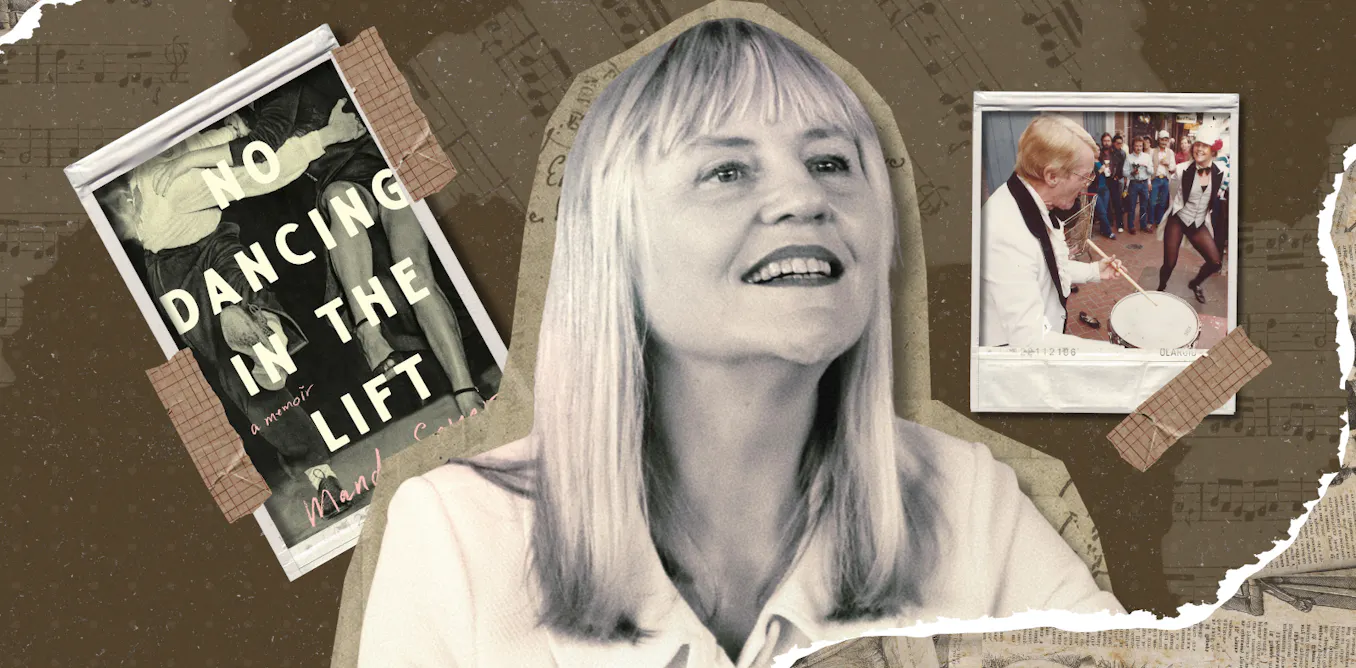Copyright theconversation

Mandy Sayer’s new book, No Dancing in the Lift, is the fourth in a series of captivating memoirs charting the author’s extraordinary life. Like her first, Dreamtime Alice, about her early years busking on the streets of Sydney, New York and New Orleans with her father, jazz drummer Gerry Sayer, it focuses on their unusually close relationship. But here, she accompanies him through his final months following a terminal cancer diagnosis in 1999. Addressed directly to Gerry, written in the second-person, the book is essentially a devotion of love for a man who resisted a traditional paternal role, but bonded with his younger daughter through music and adventure. Dreamtime Alice recalls in detail these precarious years of performing, while its sequel, Velocity backtracks to Sayer’s unstable childhood, when Sayer lived mostly with her mother and older sister, following her parents’ initial separation when she was seven. Her third memoir, The Poet’s Wife moves forward again, picking up where Dreamtime Alice leaves off, as the author embarks on a tumultuous ten-year relationship with her first husband, a prize-winning African American poet. With No Dancing in the Lift, Sayer appears to complete the quartet, weaving key memories and experiences from her first three books into a moving account of her father’s final year. Simultaneously chronicling her burgeoning love for playwright Louis Nowra, whom she eventually marries, Sayer avoids the traditional territory of the grief memoir by producing a parallel narrative of new beginnings, alongside her sorrow. Eternally forgiving her father The story opens ten days after Gerry’s death, with Sayer arriving to clear out his flat in the Sydney harbourside area of The Rocks. Everything is as he left it; an ashtray littered with roaches, a marked-up racing guide, an array of stolen pub crockery, his drumkit, some sheet music stashed in a spare fridge and a bong half full of water. As she wanders through the apartment, she lingers over the photographs lining the walls. Portraits of Gerry in the big bands and quartets he played with during the 1940s and 1950s hang next to images of him performing in public with her, knocking out the rhythms on a snare drum while she tap dances in her tailcoats. Now in her mid-thirties and a successful writer, this Mandy is a far cry from the joyful but naive young dancer caught in the pictures. After the risky but carefree days of entertaining crowds on street corners with Gerry, she has spent a painful decade in the US with her first husband and endured a bitter divorce, but has since established herself as a successful writer. In Sydney, Sayer lives within walking distance of Gerry’s home. She is studying for a PhD while working on an anthology about the social history of Kings Cross with Nowra, whom she’s met through a mutual friend. But the past year has been a difficult one, with lung cancer snatching her beloved father from his active life and consigning him to a hospice bed within a matter of months. Without the dominant presence of the parent who, at turns, has been more like a mischievous brother or a self-centred child, Sayer now faces uncertainty and heartbreak. In order to find hope for the future, she must try to reckon with the past – and the family trauma that was largely sparked by Gerry’s refusal to settle down. An entertaining individual who prioritises his music above all else, Gerry has always refused to grow up. For Sayer, this constitutes his appeal. Staunchly avoiding all adult responsibilities, Gerry is relentlessly upbeat, unpredictable, spontaneous and fun to be around, more like a mate than a dad. He is also irresponsible, self-centred and inconsiderate. But she is eternally forgiving towards him – despite the way his behaviour affects her life. Over the course of their years together, Sayer has moulded herself into her father’s idea of the perfect woman. Determined not to let him down by having children (like her mother, Betty, who died in 2005, did), she has focused on becoming entirely creative and artistic, rather than contemplate raising a family. As one of the three surviving children Gerry claimed not to want, the irony of this seems lost on her. Nor does she stop to wonder what Betty might have gone through. Instead, she buys wholesale into the very gendered notion that you can’t mix motherhood with creative pursuits. In the US, life with Gerry means having no friends her own age, no personal space, no financial security, and no one to provide her with emotional and physical support. Having outshone her siblings by proving her worth to her father as a performer and drinking partner at the age of 16, she becomes over-identified with him – and he with her. There is a distinctly uncomfortable aspect to this. Throughout the memoirs, Sayer hints at the transgressive nature of her relationship with Gerry, describing how he calls her his hash baby because she was conceived while he was having the best sex of his life after swallowing a block of Moroccan Gold. She recalls how he greets her by engulfing her “like someone in love”, how he wakes up one morning and tells her he’s had a wet dream in the bed they share, how she loses her virginity to a junkie after doing acid with Gerry, while he sleeps in the same room. Most disturbingly of all, she writes of how he gets drunk and declares “You are ME. YOU are me!”. She happily admits he has shaped her imagination by treating her as a confidante and refutes others’ perceptions of her and Gerry as being inappropriately intimate. She even declares one of the reasons she began to write was because Gerry, through missing school, never learned to read, so is unable to record his own stories. Tragically, she worries he will die feeling disappointed in her and withholding his love. In many ways, Sayer’s books challenge the accepted boundaries of the father-daughter relationship. They raise questions about the need to love and to be loved – as a child and as a parent – and the way this feeds into adult partnerships. And they consider the human desire for acceptance and validation and how this might, when unmet, lead to being used – and worse, abused. Sayer’s focus is very much on storytelling and like Gerry, she knows how to concoct a good one, but her lack of analytical awareness and limited introspection leaves a lot unresolved. Of course, that’s not necessarily a bad thing. But it’s impossible not to wonder about what happens to independent identity, self agency and the individuation process when one person has become so enmeshed with another. ‘Don’t get upset’ The first sign of trouble occurs on a trip to the cinema, when Sayer notices her 78-year-old father has lost weight. Putting her concerns aside, she takes him for a drink after the movie and is surprised when he requests her help with making a will. Despite his age, Sayer senses Gerry is hiding something. It takes a good few weeks of declining health – and a persistent, bloody cough – to persuade him to see a doctor. Gerry has good reason to avoid hospitals. Born with both a cleft lip and a cleft palate, he spent the first seven years of his life undergoing surgery. He is also proud and stubborn, and forbids Sayer to tell anyone about his illness. This leaves her to shoulder the emotional and physical burden of the news alone. Aside from her writing, men are Sayer’s main distraction from caring for Gerry. Her collaboration on the Kings Cross project with unhappily married Nowra evolves into a deeply personal connection, while a chequered affair with a jazz musician takes her to Amsterdam for a much needed break. But Gerry remains her guiding light, and it’s not until he dies that she is psychologically and emotionally released into being fully committed to Nowra, knowing her father has actively encouraged their bond. To a degree this is understandable, but Sayer’s situation is complicated by the profoundly merged nature of her and Gerry’s relationship. As Gerry deteriorates, other family members help out sporadically, including Sayer’s older sister Lisa. An aged homecare worker, Lisa flies down from the mid north coast and confronts Gerry with his selfishness, while Sayer’s psychiatrist warns her against letting her father repossess her life. But with nobody else willing or able to look after him properly, for better or worse, Sayer’s intense attachment to her adored parent triumphs over others’ concerns. She sets out to be his sole carer with pragmatic resolution and a sense of fortitude that soothes her swelling grief. Near the beginning of the book, Sayer ponders her “aversion to suffering” and approaches her father’s imminent death with a bittersweet air. She emphasises his boyish, larrikin character, letting it shine through even the most sober scenarios: from the consulting rooms of a shockingly clinical oncologist to the final hospice stay. There, despite his obvious terror of dying, Gerry continues to crack jokes and spin anecdotes. Tellingly, his last words to Sayer are, “Don’t get upset.” This parting instruction says everything about Gerry and his general attitude to life, but it is very much a double-edged sword. Sayer’s depiction of her father as a charismatic entertainer with a gift for finding the positive in every situation suggests someone invested in denial. His feverish insistence on silver linings borders on delusional. While Sayer is perpetually dazzled by this conjuring trick, her readers are more likely to question Gerry’s dissociation from reality – and to weigh up the cost to his daughter. Dreamtime Alice Dreamtime Alice unpacks that cost, perhaps unwittingly, by revealing Gerry’s extensive impact on his adult child. The book juxtaposes the spontaneity and excitement of Sayer and Gerry’s bohemian lifestyle with the gritty reality of their existence as itinerant street performers, jostling from one tiny, rundown single-bed accommodation to the next. But as they beat off police and escape from unpaid tenancies, their cartoonish capers are fraught with danger. Sayer, still in her early 20s, is brimming with internal conflicts as she tries to mask her vulnerability with a streetwise persona. Gerry, who proudly relates to her as a friend, fails to safeguard her from predatory older men, psychopaths, drug dealers, fraudsters and poverty, leaning into their co-dependent dynamic without assuming an adult role. In New Orleans, he tries to persuade his daughter to work at the ironically named Big Daddy’s strip club. In New York, she is sexually coerced by one of Gerry’s closest friends, a much older man who sells drugs and sleeps with sex workers, and who gives her a urinary tract infection and herpes. Allergic to the UTI medication, she ends up fighting for her life in hospital. Not only has Gerry failed to intervene with his rapacious associate: he lets his childhood fear of hospitals override his daughter’s needs and doesn’t see her until she is discharged. Left alone with the medical staff, Sayer finally struggles to keep faith in her “beautiful, difficult father”, whose incapacity for care and protection has been horribly exposed. She remembers the way his presence was “transparent as dust” when she was a child. She also reflects on how her emerging adult relationship patterns are beginning to resemble those of her mother, Betty, whose heartbreaking story is explored more fully in her next book, Velocity. Short-lived childhood happiness In her second memoir, the prequel to Dreamtime Alice, Sayer elaborates on the short-lived happiness of her childhood with Gerry, and conveys the legacy of his many absences. But while she writes of her parents’ passion for each other, Sayer doesn’t adequately connect her mother’s misery with Gerry’s behaviour. Instead, she appears to hold Betty responsible for all that goes wrong, claiming her mother is a liar and a drunk. Gerry’s own, excessive drink and drug habits, selfish choices and unthinking actions are never problematised, despite the fact he continually leaves Betty unsupported, impoverished and home alone with three children. When Sayer discovers he has told a fundamental lie about one of his disappearances – and another woman – she rallies to his side, convincing herself lying can be beneficial after all. When he is around, Gerry thinks only of himself. On one occasion, he rips out the bathroom and replaces it with a soundproof practice space, meaning Betty has to spend hours filling up an old iron tub to wash the kids while he locks himself away all day, drumming. Betty’s backbreaking labour, and who knows what kind of emotional distress, are entirely neglected in this anecdote. And this is just one example. When the couple finally separates, Gerry takes the oldest child, his only son, to live with him, while the girls stay with their mother. Betty descends into alcoholism and embarks on a string of unsuitable jobs and affairs, as she struggles to keep a roof over her children’s heads. Things worsen when she meets a much younger, unpredictable, violent Lebanese man who beats her and eventually burns down the family home. Seeking to escape such a volatile existence, Lisa, having already suffered a brutal sexual assault as a young teenager, runs away with a friend, returning only intermittently. Although there is absolutely no excuse for this man’s extreme brutality, Sayer provides no context for his psychological state either, although he appears to be suffering from complex trauma. Similarly, there is little empathy for Betty, who as a victim of abuse, is caught in a vicious cycle of fear, dependency and danger. It takes years of shifting in and out of women’s sanctuaries and emergency housing, attempting to end her life and rebounding to the source of her despair before she finally rids herself of him by moving interstate. By the end of the book, Sayer is a teenager and has reconnected with Gerry, whose long absence from her recent past serves to further his association with the good times. She joins him in Sydney, stepping into the story of Dreamtime Alice, where her efforts to escape from a troubled upbringing lead her full circle into the arms of lovers who – like the men in her mother’s life – lie, cheat and beat her. The Poet’s Wife In the first memoir’s final pages, Sayer meets her first husband, an intense, talented but tortured writer who features in The Poet’s Wife. Her third memoir details her marriage to a jealous and extraordinarily controlling partner. Psychologically scarred by fighting in Vietnam, worn down by the structural racism of living in America as a Black man, Sayer’s first husband is complex, mistrusting, angry and damaged. Although he supports and encourages Sayer towards becoming a writer herself during the decade they are together, his behaviour towards her is mostly appalling, Like her mother before her, Sayer internalises her husband’s cruelty, including gaslighting, sexual distancing, possessiveness, infidelity and duplicity. She becomes anxious and depressed, needing medication for both. He lies about his age and extramarital affairs, keeps her confined in their home without money and instructs her not to tell anyone when he goes away on his frequent, supposed work trips. Her suspicions begin to mount. Eventually, she sneaks into his university office, where she finds evidence of his many deceits. When she discovers he has a child with one of the women he insists is an ex-lover, she abruptly ends the relationship and moves back to Sydney, to be near the father she has missed. Gerry never takes to Sayer’s first husband and finds it hard to believe a Black man could become a college professor. Betty, who loves her son-in-law, overplays her acceptance of him. Either way, the issue of ethnicity appears to sit uncomfortably with Sayer’s white, Australian parents. Sayer’s own conclusion is that racism can cause psychological issues, as her poet continues to project his anguish and trauma onto her, even after she files for divorce. Five months after her return to Sydney, she has come off her medications and has rediscovered her internal balance when he arrives on the doorstep. He is erratic and angry, accusing her of having affairs, and of not wanting a child with a Black man. However, he is unable to acknowledge the terrible way he has treated her. Questionable, but shimmering Sadly, there are just a few short years between Sayer arriving back in Australia and Gerry’s diagnosis. Days before his death, he is still clinging to a delusional level of optimism by insisting a juice diet will cure him. Now, though, even Sayer draws the line, suspecting her father knows this is a fool’s errand – and that fasting is no way to spend his precious remaining time. When Gerry dies in the hospice, Sayer is fast asleep on a foldout bed by his side, having spent her father’s final hours drinking wine and listening to jazz with Nowra, her half brother Jason (the son of Betty and her abusive ex-partner), and Gerry’s musician friend, Brian. An unsympathetic nurse wakes her and orders her to pack up her father’s belongings. Everything is over very swiftly. Sayer doesn’t dwell on the scene, or her emotions, but returns to Gerry’s flat where she drains his last morphine bottle. Thankfully, after all the years of physical insecurity and emotional instability, of striving to please her father and appease her partners, Sayer finds a strong and lasting love with Nowra. Throughout Gerry’s illness, Nowra has been a considerate and supportive presence, as well as a stimulating and encouraging co-editor for their Kings Cross anthology. He recognises her worth, both as a woman and a writer, and gives her all the time she needs to ease into their relationship. Three years after Gerry dies, Sayer and Nowra marry in Darlinghurst. The band who played at Gerry’s funeral perform jazz classics, Gershwin numbers and Stevie Wonder songs. The clergyman fluffs his lines while reciting The Lord’s Prayer, imploring his god to “lead us into temptation”, and the wedding party parade through the streets of Kings Cross, in a jubilant tribute to the area that first brought bride and groom together. Sayer, deservedly, enjoys a happy ending after all. And yet, at the close of the book, Sayer reverts to her father, declaring she is just as attached to Gerry as she was while he was alive. Now she feels he is showing her how to grow old, “without growing up”: an idea favoured by baby boomers all over the privileged world. For Sayer, this notion has a personal resonance, of course. Gerry was not so typical of his generation. A compelling story that serves, like its companion volumes, as a glowing tribute to a challenging and memorable trickster, No Dancing in the Lift remembers a flawed father in all his ragged glory. Unresolved in places, questionable at times, it nevertheless shimmers with love – and showcases Sayer’s impeccable gift for storytelling.



